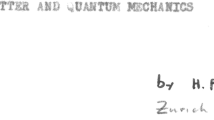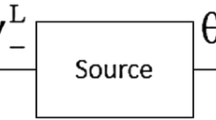Abstract
Awareness is seen as the interior perception of the wave form of the substance of which the body is composed. Traditional “reality” is limited to exterior perceptions. Mind/body dualism is analogous to what physicists once thought was a contradiction between the corpuscular and the wave nature of light. We are subject both to the laws of classical mechanics and to those that govern quantum events. Determinism is an incorrect assumption for the study of human behavior. A research program is proposed to evaluate the assumptions outlined herein, and the social implications for the scientific study of behavior are examined.
Similar content being viewed by others
References
BOHM, DAVID. (1997). Wholeness and the implicate order. New York: Routledge.
CHARDIN, PÈRE TEILHARD DE. (1959). The phenomenon of man. New York: Harper and Row.
CROSSAN, JOHN DOMINIC. The historical Jesus. New York: Harper/Collins, Publishers.
DAVIES, P. C. W., & BROWN, J. (Eds.). (1988). Superstrings: A theory of everything? New York: Cambridge University Press.
EINSTEIN, ALBERT. (1961). Relativity: The special and the general theory. New York: Three Rivers Press.
ESTES, W. K. (1950). “Toward a statistical theory of learning.” Psychological Review, 57, 94–107.
FEYNMAN, RICHARD. (1965). The character of physical law. Cambridge: Mit Press.
GELL-MANN, MURRAY. (1994). The quark and the jaguar: Adventures in the simple and the complex. New York: W. H. Freeman & Company.
GLEICK, JAMES. (1988). Chaos: Making a new science. New York: Penguin Books.
GRIBBEN, J. (1984). In search of Schrödinger’s cat. New York: Bantam.
HAHN, HANS. (1934). Die Bedeutung der Wissenschaftlichen Weltauffassung, inbesondere für Mathematik und Physik. Erkenntnis 1, 1930, 97.
HAWKING, STEPHEN. (1988). A brief history of time: From the big bang to black holes. New York: Bantam Books.
HANSEL, C. E. M. (1966). Esp: A scientific evaluation. New York: Charles Scribners.
HAYWARD, JEREMY. (1997). Letters to Vanessa. Boston & London: Shambhala.
HERBERT, NICK. (1985). Quantum reality. New York: Anchor Books.
HERBERT, NICK. (1989). Faster than light. New York: Plume.
JUNG, C. G. (1961). Memories, dreams, & reflections. (Aniela Jaffe, Trans.). New York: Alfred A. Knopf.
KANTOR, JACOB R. (1924). Principles of psychology, Volume I. New York: Alfred E. Knopf.
KANTOR, JACOB R. (1926). Principles of psychology, Volume II. New York: Alfred E. Knopf.
KRAUSS, LAWRENCE M. (1995). The physics of Star Trek. New York: HarperPerennial.
LEDERER, LEON. (1993). The God particle. New York: Dell Publishing.
LORENTZ, H. A., EINSTEIN, A., MINKOWSKI, H., & WEYL, H. (1952). The principle of relativity. New York: Dover Publications, Inc.
PEAT, H. DAVID. (1987). Synchronicity. New York: Bantam Books.
SKINNER, B. F. (1938) The bbehavior of organisms: An experimental analysis. New York, London: D. Appleton-Century Company, Inc.
TIPLER, FRANK J. (1994). The physics of immortality. New York: Anchor Books.
ZOHAR, DANAH. (1990). The quantum self. New York: Quill/William Morrow.
ZUKAV, GARY. (1979). The Dancing Wu Li Masters. New York: Quill/William Morrow.
Author information
Authors and Affiliations
Additional information
Edward J. Green is a former student and colleague of both Jacob R. Kantor and B. F. Skinner. He is now Guerry Professor Emeritus at the University of Tennessee at Chattanooga.
Rights and permissions
About this article
Cite this article
Green, E.J. Quantum Mechanics and the Analysis of Behavior: Reflections and Speculations. Psychol Rec 52, 19–32 (2002). https://doi.org/10.1007/BF03395412
Published:
Issue Date:
DOI: https://doi.org/10.1007/BF03395412




